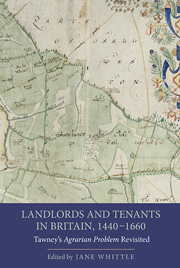Book contents
- Frontmatter
- Contents
- List of Figures
- List of Tables
- Abbreviations
- List of Contributors
- Acknowledgements
- Foreword
- Introduction: Tawney's Agrarian Problem Revisited
- 1 The Agrarian Problem, 1440–1520
- 2 Common Law and Manor Courts: Lords, Copyholders and Doing Justice in Early Tudor England
- 3 Negotiating Enclosure in Sixteenth-Century Yorkshire: The South Cave Dispute, 1530–1536
- 4 The Politics of Enclosure in Elizabethan England: Contesting ‘Neighbourship’ in Chinley (Derbyshire)
- 5 The Loss of Athelstan's Gift: The Politics of Popular Memory in Malmesbury, 1607–1633
- 6 In Search of the Scottish Agrarian Problem
- 7 The Transfer to Leasehold on Durham Cathedral Estate, 1541–1626
- 8 The Financial Rewards of Winning the Battle for Secure Customary Tenure
- 9 Risks and Rewards in Wasteland Enclosure: Lowland Lancashire c.1500–1650
- 10 Improving Landlords or Villains of the Piece? A Case Study of Early Seventeenth-Century Norfolk
- 11 The Agrarian Problem in Revolutionary England
- 12 Agrarian Capitalism and Merchant Capitalism: Tawney, Dobb, Brenner and Beyond
- Conclusions
- Select Bibliography
- Index
3 - Negotiating Enclosure in Sixteenth-Century Yorkshire: The South Cave Dispute, 1530–1536
Published online by Cambridge University Press: 05 September 2013
- Frontmatter
- Contents
- List of Figures
- List of Tables
- Abbreviations
- List of Contributors
- Acknowledgements
- Foreword
- Introduction: Tawney's Agrarian Problem Revisited
- 1 The Agrarian Problem, 1440–1520
- 2 Common Law and Manor Courts: Lords, Copyholders and Doing Justice in Early Tudor England
- 3 Negotiating Enclosure in Sixteenth-Century Yorkshire: The South Cave Dispute, 1530–1536
- 4 The Politics of Enclosure in Elizabethan England: Contesting ‘Neighbourship’ in Chinley (Derbyshire)
- 5 The Loss of Athelstan's Gift: The Politics of Popular Memory in Malmesbury, 1607–1633
- 6 In Search of the Scottish Agrarian Problem
- 7 The Transfer to Leasehold on Durham Cathedral Estate, 1541–1626
- 8 The Financial Rewards of Winning the Battle for Secure Customary Tenure
- 9 Risks and Rewards in Wasteland Enclosure: Lowland Lancashire c.1500–1650
- 10 Improving Landlords or Villains of the Piece? A Case Study of Early Seventeenth-Century Norfolk
- 11 The Agrarian Problem in Revolutionary England
- 12 Agrarian Capitalism and Merchant Capitalism: Tawney, Dobb, Brenner and Beyond
- Conclusions
- Select Bibliography
- Index
Summary
Writing a hundred years ago, R. H. Tawney recognised the complexity of the term ‘enclosure’. In the first few pages of The Agrarian Problem he asks, ‘what exactly did enclosing mean?’ and the book goes on to draw attention to the wide range of agricultural changes conventionally labelled as enclosure. His most significant contribution in this vein was probably to document the efforts of the peasantry to enclose land, but the book also discusses a huge variety of modifications to existing agricultural practice. Thus he makes reference to piecemeal enclosure and the exchange of open-field strips to create consolidated holdings, to the enclosure and reallocation of fields and meadows ‘by agreement’, to encroachment on commons and meadows, to the enclosure and improvement of wastes and pastures, and to depopulating enclosures and engrossment. More than fifty years later, in her classic chapter on the subject, Joan Thirsk echoed a great deal of what Tawney had said. For her, enclosure was ‘a very loose general term’ which meant different things in different places. While primarily focusing on the enclosure of Midland arable and its conversion to pasture, Thirsk nevertheless highlighted the varying regional experiences of enclosure with a clarity Tawney had not. Later scholars have added much to our knowledge of these different types of enclosure and their regional histories, but the quotation remains a valuable reminder that the term enclosure is shorthand for a wide variety of agricultural changes which differed in their form, purpose and impact.
- Type
- Chapter
- Information
- Landlords and Tenants in Britain, 1440-1660Tawney's 'Agrarian Problem' Revisited, pp. 52 - 66Publisher: Boydell & BrewerPrint publication year: 2013



